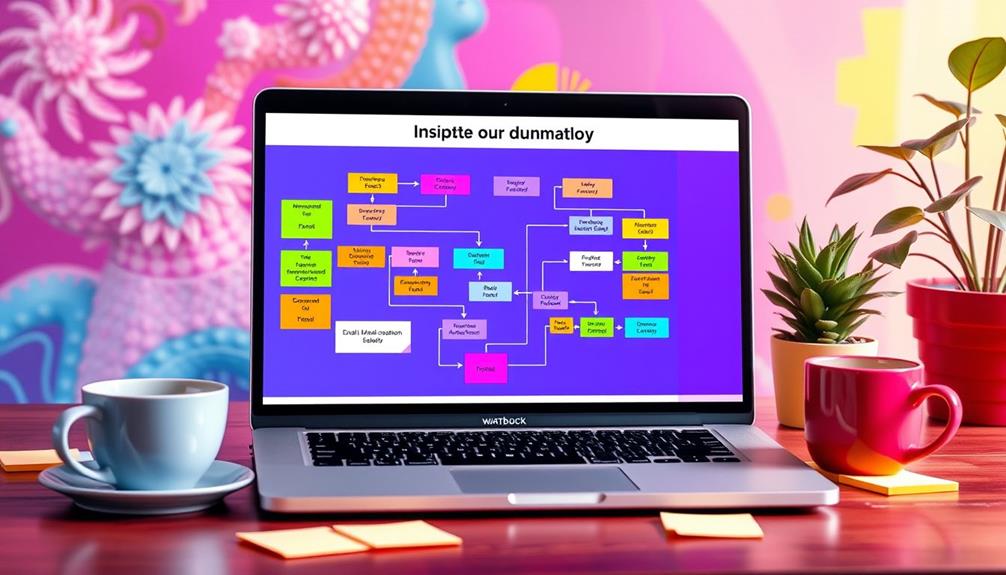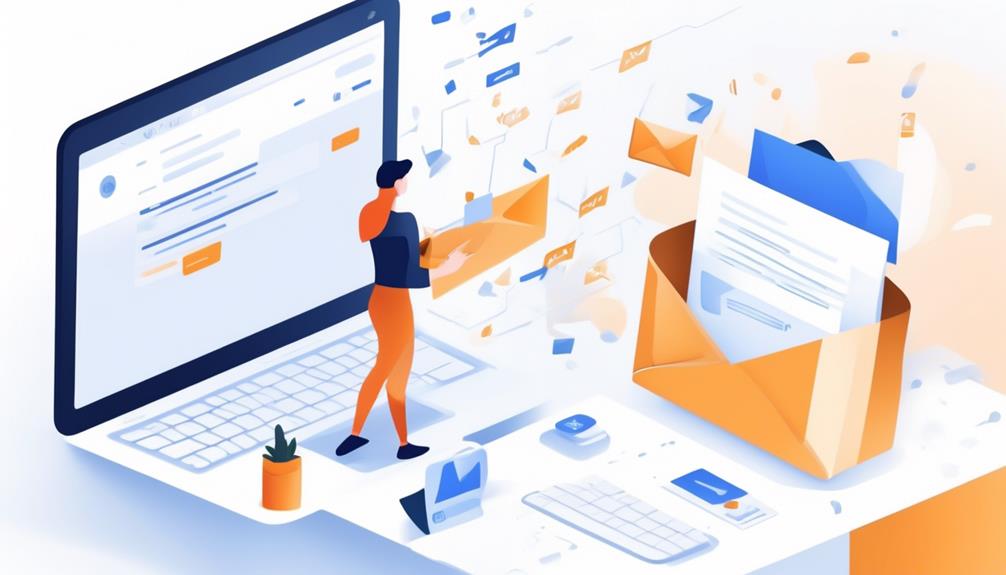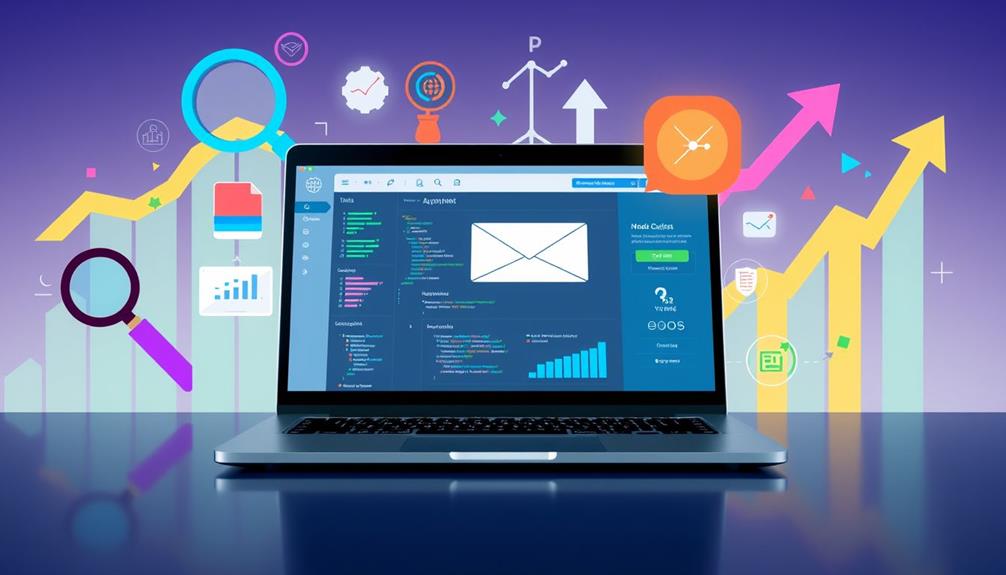Personalization at scale is all about using advanced email automation techniques to boost your engagement and conversion rates. Start by leveraging AI to analyze customer data, allowing you to segment your audience effectively. Use dynamic content and personalized subject lines to capture attention and enhance relevance. Make sure to collect subscriber preferences to tailor your messaging even further. Don't forget to measure engagement metrics like open and click-through rates to optimize your strategies. By automating these processes carefully, you'll maintain a personal touch. Keep going, and you'll discover even more strategies to elevate your email campaigns.
Key Takeaways
- Utilize AI-driven segmentation to create targeted customer groups based on behavior, preferences, and interactions for more effective email campaigns.
- Implement dynamic content automation to deliver personalized messages in real-time, enhancing user engagement and satisfaction.
- Leverage predictive analytics to anticipate customer needs and tailor messaging, improving conversion rates and overall campaign effectiveness.
- Employ trigger-based automation to capture and analyze data during key interactions, refining audience segmentation for more relevant outreach.
- Regularly test and optimize email content and send times through A/B testing and engagement metrics to ensure maximum impact and relevance.
Importance of Personalization in Email Marketing
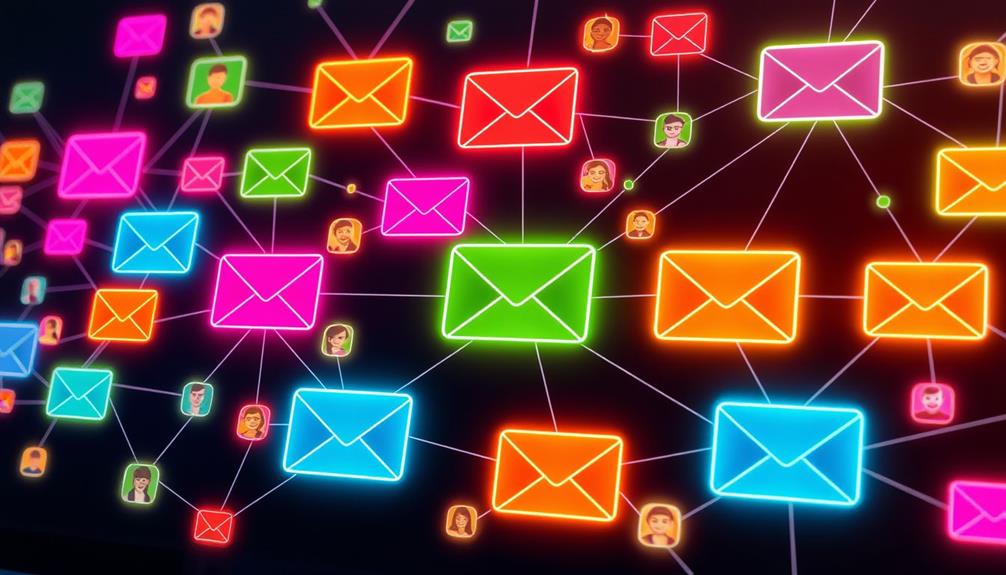
When it comes to email marketing, personalization isn't just a nice touch—it's vital for success. You'll find that personalized emails achieve six times higher transaction rates compared to generic ones. This statistic highlights the incredible power of email personalization.
With 72% of consumers preferring tailored emails, it's clear that there's a strong demand for relevant content in your marketing strategies. Utilizing effective email marketing strategies guarantees that your outreach resonates with your audience, leading to better engagement and loyalty effective email marketing strategies.
Effective personalization fosters customer engagement and loyalty. When you send emails that resonate with your audience, you enhance their trust and create a sense of value. This connection is essential for building lasting relationships with your customers.
In fact, personalized emails are associated with a 20% increase in sales, demonstrating how tailored communication can positively impact your business performance.
To scale these efforts efficiently, consider implementing Marketing Automation. This technology allows you to streamline your personalization strategies, making it easier to deliver relevant content to the right people at the right time.
Leveraging AI for Personalization

Harnessing the power of AI can transform how you personalize your email marketing efforts. By leveraging AI, you can analyze extensive customer data to create targeted segments, ensuring your emails resonate with specific groups.
This level of Email Marketing Personalization enhances engagement and satisfaction among your audience, especially as cybersecurity measures become increasingly essential in protecting user data. Additionally, ethical hackers play an important role in identifying vulnerabilities, allowing businesses to maintain trust while executing personalized strategies.
Here are three ways AI can elevate your email campaigns:
- Predictive Content Personalization: Use customer interaction data to tailor personalized content and offers, similar to how streaming services recommend shows. This approach can lead to improved open rates.
- Dynamic Content: AI enables you to automate the creation of dynamic content, ensuring your messages are relevant and timely. This real-time optimization keeps your audience engaged and informed.
- Optimized Timing: With automation through AI, you can analyze individual customer behaviors to determine the best times for sending emails. This strategy greatly boosts your open and conversion rates.
Data Collection Strategies
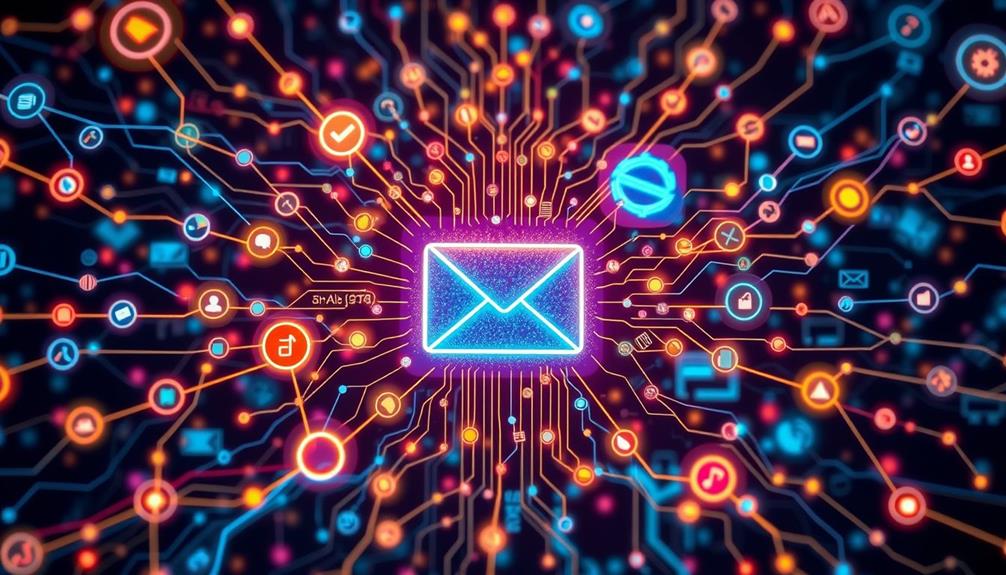
Effective data collection strategies are essential for understanding your audience and enhancing email marketing efforts. By gathering key subscriber information like names, locations, and preferences, you can gain extensive insights into customer behavior. This knowledge allows you to create personalized emails that resonate with your audience.
Utilizing CRM systems is a powerful way to store and manage subscriber data. Here are some effective data collection methods to reflect upon:
| Strategy | Benefits |
|---|---|
| Dynamic web forms | Collect real-time data on preferences |
| Trigger-based automation | Capture data during key interactions |
| Regular interaction analysis | Reveal insights for better segmentation |
| Personalized fields in emails | Enhance engagement through tailored communication |
Implementing dynamic forms on your website can facilitate immediate data collection. By analyzing customer interactions and purchase history, you can refine segmentation, ensuring more targeted messaging. Remember, employing marketing automation tools during critical moments—like sign-ups or purchases—will keep your subscriber profiles up-to-date for ongoing personalization. These strategies are fundamental in creating an effective email marketing campaign that truly connects with your audience.
Effective Segmentation Techniques
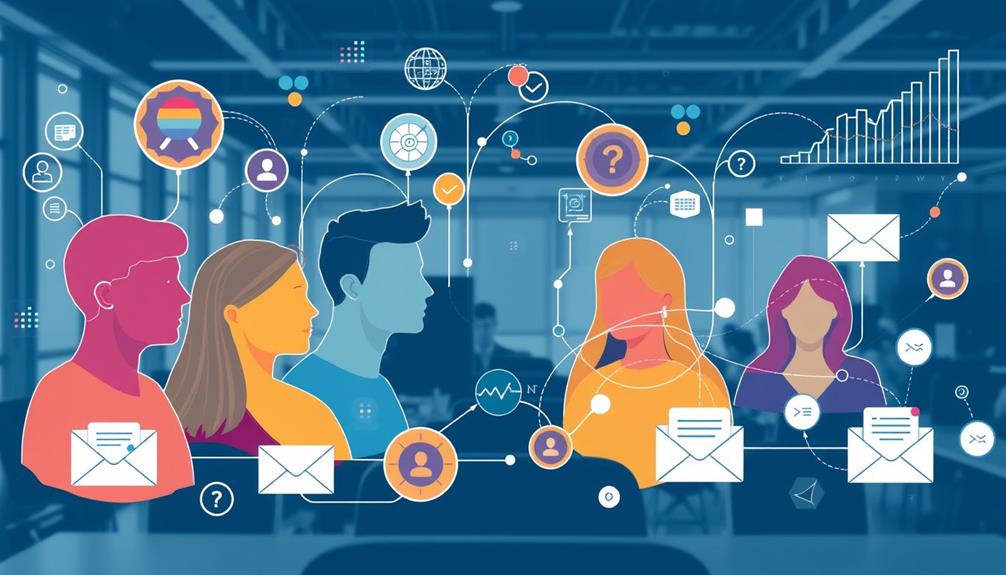
To boost your email campaigns, you need to analyze audience behavior closely.
Utilizing techniques such as goal tracking pitfalls can help you identify the most effective strategies for engagement.
By leveraging dynamic content creation and timely engagement strategies, you can tailor messages that truly resonate with your subscribers.
This approach not only increases relevance but also drives higher engagement rates.
Audience Behavior Analysis
Understanding audience behavior is essential for crafting targeted email campaigns that truly resonate. By implementing a holistic SEO approach, you can guarantee that your email content aligns with user experience and engagement metrics.
Through effective audience behavior analysis, you can utilize customer data to segment your audience meaningfully, greatly boosting engagement rates. Here are three effective segmentation techniques you should consider:
- Behavioral Segmentation: Focus on past interactions and purchase history. This approach can lead to a staggering 760% increase in revenue, as it tailors your messaging to specific interests.
- Geographic Segmentation: Deliver localized content that aligns with events or conditions in your audience's area. This enhances the personalized experience and increases the likelihood of engagement.
- Technographic Segmentation: Analyze the tools and technologies your audience uses. This helps you create targeted segments that address their unique pain points and needs.
Dynamic Content Creation
Crafting emails that resonate with your audience means going beyond basic personalization. You can achieve this by leveraging dynamic content, which tailors your email messages based on specific segmentations like demographics or past purchase behavior. By utilizing customer data effectively, you can create personalized experiences that truly engage each recipient.
Additionally, understanding your audience's preferences, similar to how effective hamster care involves tailored nutrition and environment, can enhance engagement strategies.
Effective segmentation techniques allow you to categorize your audiences into targeted groups, increasing engagement rates by up to 40%. For instance, behavioral segmentation analyzes customer interactions across multiple channels, helping you align your messages with individual preferences, thereby boosting conversion likelihood.
Brands like Nordstrom exemplify the power of dynamic content by showcasing personalized product recommendations based on customers' past purchases and browsing history. This greatly enhances user experience and drives engagement.
Moreover, advanced segmentation strategies, including real-time data analysis, enable you to adjust email content on-the-fly. This guarantees recipients receive the most relevant offers at the right moment, leading to higher open rates and engagement in your email marketing campaigns.
Embrace dynamic content creation, and watch your email strategies transform into powerful tools for connection and conversion.
Timely Engagement Strategies
Timely engagement strategies hinge on effective segmentation techniques that make your email campaigns more relevant and impactful. By categorizing your email recipients based on specific factors, you can enhance personalization throughout the customer journey.
For example, understanding common financial terms can help you craft messages that resonate with audiences in the finance sector. Here are three advanced segmentation techniques to reflect upon:
- Behavioral Segmentation: Use data from various channels to tailor your campaigns, improving open and click-through rates. By sending messages that resonate with specific audience interests, you're more likely to engage your recipients.
- Geographic Segmentation: Craft messages that are contextually relevant based on recipients' locations. This becomes particularly effective during local events or seasonal changes, ensuring your emails hit home when they matter most.
- Technographic Segmentation: Identify prospects' technology preferences to enable targeted outreach. By addressing potential pain points directly, you'll enhance the relevance of your emails and drive engagement.
Regularly analyzing engagement metrics is essential to refine these strategies. As customer behaviors and preferences evolve, your segmentation should adapt, ensuring your email campaigns continue to deliver timely engagement strategies that resonate.
Creating Personalized Content

In the domain of email marketing, creating personalized content is essential for capturing your audience's attention and driving engagement. By leveraging customer data, you can tailor your messages to fit individual preferences, ensuring that your email campaigns resonate with each recipient.
Utilizing advanced automation techniques like dynamic content allows you to customize emails in real time. This means your messages can adapt based on user behavior, providing a unique experience for every subscriber. Personalized subject lines alone can boost your open rates by 26%, highlighting the importance of targeted messaging.
Here's a quick look at how you can personalize content effectively:
| Strategy | Benefit |
|---|---|
| Behavioral Segmentation | Increases relevance |
| Dynamic Content | Enhances user experience |
| Real-Time Inventory | Avoids customer dissatisfaction |
With automation tools like Litmus Personalize, you can create numerous variations of your emails without needing multiple versions of the same campaign. By integrating these elements, you'll not only increase engagement but also foster stronger relationships with your customers.
Optimizing Email Timing

When you optimize email timing, you're setting your messages up for success by sending them during peak engagement hours.
It's also essential to take into account your audience's time zones to guarantee your emails land in their inboxes at the right moment.
For instance, understanding the timing of significant events, like Billy Gilmans secret wedding, can provide insights into when your audience might be more engaged.
Peak Engagement Timing
Finding the right moment to hit "send" can make all the difference in your email marketing success. Timing enhancement is essential for maximizing engagement and guaranteeing your messages resonate with your audience.
By leveraging customer behavior patterns, you can personalize at scale and enhance your email marketing efforts. Here are three key strategies to reflect on:
1. Analyze Engagement Data: Explore your past campaigns to identify peak engagement times. Studies show that sending emails on Tuesdays and Thursdays, especially Tuesdays, yields the highest open rates.
Additionally, take into account the impact of factors like seasonal trends and public holidays on customer behavior, similar to how cold medications are selected based on specific symptoms.
2. Utilize AI for Real-Time Adjustments: Employ AI tools to continuously analyze customer behavior. This enables you to adjust send times dynamically, guaranteeing your emails hit inboxes when recipients are most likely to engage.
3. Segment Your Audiences: Group your subscribers based on their engagement patterns and time zones. This guarantees that your emails arrive at prime local times, further boosting your response rates.
Time Zone Considerations
Maximizing email timing requires a keen understanding of your audience's time zones. Timing maximization can greatly enhance your open rates by ensuring that your emails land in inboxes when recipients are most likely to engage. By leveraging geographic data, you can tailor your email campaigns to reach various segments at their peak engagement times.
Here's a quick look at how different time frames can impact your strategy:
| Time Zone | Ideal Send Time | Expected Open Rate Increase |
|---|---|---|
| Eastern Standard | 8 AM – 10 AM | Up to 22% |
| Central Standard | 9 AM – 11 AM | Up to 20% |
| Pacific Standard | 10 AM – 12 PM | Up to 18% |
Using tools that adjust sending times automatically can help you deliver personalized messages that resonate more with your audience. This approach doesn't just boost open rates; it fosters a more engaging email experience, reinforcing brand loyalty. By putting time zone considerations at the forefront of your strategy, you're on your way to creating impactful, relevant email campaigns.
Measuring Engagement Metrics
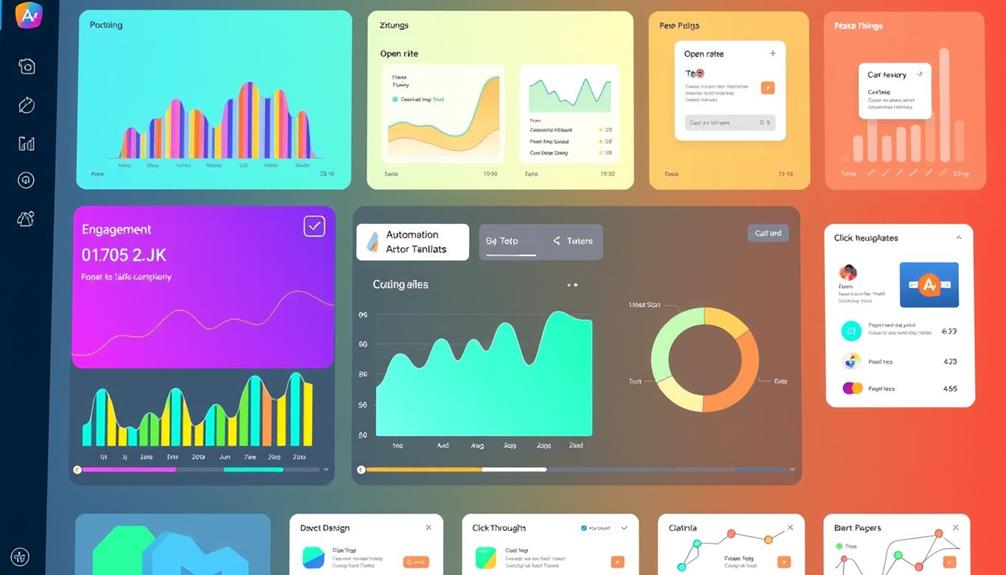
Effective email marketing hinges on measuring engagement metrics like open rates, click-through rates (CTR), and conversion rates. Different strategies, like personalization, can greatly enhance your campaign outcomes. In fact, using personalized subject lines can boost open rates by an impressive 26%, showing the importance of tailoring content to your audience's preferences and interests.
Astrology and Attractiveness suggests that aligning your messaging with what appeals to your audience can further improve engagement.
To make the most of your email strategy, consider these three key actions:
- A/B Testing: Experiment with different subject lines and content to see what resonates best with your audience. This process provides valuable insights that help refine your approach.
- Timing Optimization: Utilize analytics tools to identify the best times to send your emails. Proper timing can enhance open rates by aligning your messages with peak engagement periods.
- Monitor Engagement Metrics: Regularly track these metrics to adapt your strategy in real-time. This continuous improvement loop not only boosts customer loyalty but also increases overall campaign effectiveness.
Overcoming Automation Challenges

While measuring engagement metrics is essential for refining your email strategy, overcoming automation challenges is equally important to guarantee your campaigns resonate with your audience. Many marketers worry that automation could hinder personalization, with 61% expressing concerns.
To address this, you must find a balance: make sure your email content remains engaging and tailored to each recipient. Additionally, understanding potential risks, such as avoiding gold IRA scams, is critical for maintaining customer trust. Data security is another significant challenge. Mishandling customer data can lead to privacy violations and a loss of trust. Always implement ethical considerations regarding data use and address potential biases. This not only safeguards your customers but also enhances your brand's reputation.
Continuous analysis and adaptation of your automated processes are essential. Regularly reviewing customer engagement metrics will help you refine your strategies and make certain that your automation efforts deliver personalized experiences.
Future Trends in Email Personalization

As AI continues to shape the marketing landscape, you'll see a surge in AI-driven insights that enhance your email personalization strategies.
Predictive personalization techniques will help you anticipate customer needs, while integrating your email campaigns with other channels will create a seamless experience.
Embracing these trends will keep your email marketing efforts relevant and effective.
AI-Driven Insights
AI-driven insights are transforming how businesses approach email personalization, making it easier than ever to connect with customers on a meaningful level. With the help of machine learning algorithms, marketers can analyze customer behavior patterns, leading to more highly relevant email content that boosts engagement rates.
Here are three key aspects of AI-driven insights in email marketing:
- Natural Language Processing (NLP): This technology enhances personalized interactions by understanding customer preferences, creating engaging, conversational experiences.
- Predictive Analytics: By anticipating customer needs, you can craft tailored messaging that drives higher conversion rates and increases customer satisfaction.
- Real-Time Data Analysis: This allows for dynamic content adjustments in your email campaigns, ensuring that your messaging is timely and relevant based on the latest interactions and trends.
As the AI marketing sector is projected to grow to $40.1 billion by 2027, adopting these ai-driven insights will be essential for achieving personalization at scale.
Leveraging these advanced techniques won't only optimize your email strategies but also foster stronger connections with your audience.
Predictive Personalization Techniques
Marketers are increasingly turning to predictive personalization techniques to enhance their email campaigns and better connect with consumers. By leveraging customer interaction data, you can anticipate future behaviors and send tailored messages that resonate with individual preferences. This approach substantially boosts engagement rates, as it allows you to provide relevant content at the right time.
Utilizing AI algorithms, predictive personalization can analyze past purchase behavior and browsing patterns, similar to how streaming services recommend shows based on user history. Companies employing these strategies have seen up to a 20% increase in conversion rates, proving that timely content truly matters.
Real-time data processing is essential in this landscape, enabling you to adjust your email content dynamically based on emerging trends and customer feedback. This guarantees your communications remain relevant and impactful.
As predictive personalization evolves, techniques like machine learning and natural language processing will help you automate the creation of highly customized email experiences at scale. Embracing these advancements not only enhances your email marketing efforts but also strengthens your relationship with customers, ultimately leading to better business outcomes.
Integration With Other Channels
The integration of email marketing with other digital channels is becoming essential for creating a seamless and engaging customer experience. By harmonizing your efforts across platforms, you can enhance the effectiveness of your campaigns and boost customer satisfaction.
Here are three key benefits of this integration:
- Improved Personalization: By synchronizing data from various channels, you can deliver highly personalized emails that resonate with your audience, leading to better engagement.
- Real-Time Adaptation: As AI technology evolves, you'll be able to analyze customer interactions in real-time. This means you can dynamically adjust your email content based on what's happening across other channels, making your marketing more responsive.
- Increased Conversion Rates: Implementing omnichannel strategies can boost conversion rates by up to 30%. Personalized messaging across all touchpoints guarantees your brand remains relevant, no matter where customers engage.
Best Practices for Implementation

When you're implementing email automation, focusing on best practices can make all the difference in your campaign's success. Start by utilizing advanced segmentation techniques like behavioral and demographic data analysis. This enhances your targeting accuracy and can lead to a 20% increase in sales through personalized experiences.
Next, leverage automation tools such as Litmus Personalize to create dynamic email content that adapts to individual subscriber preferences. This approach can boost engagement rates by up to 50% for tailored campaigns.
Regularly review and optimize your emails based on customer interaction metrics. This keeps your content relevant and guarantees a consistent increase in open and click-through rates.
Incorporate real-time inventory updates within your automated emails to avoid promoting out-of-stock items, which fosters trust and enhances user experience.
Finally, don't underestimate the power of personalization in your subject lines and content. Doing so can elevate your email open rates by 26%, capturing subscriber attention effectively.
Frequently Asked Questions
What Is an Example of Personalization at Scale?
An example of personalization at scale is when you receive tailored product recommendations based on your browsing history. This approach enhances your shopping experience, making it more relevant and engaging, ultimately increasing your satisfaction and loyalty.
What Does Personalisation at Scale Mean?
Personalization at scale means crafting unique messages for large audiences, making each recipient feel valued. It's about using data to tailor your outreach, ensuring your communication resonates with individual preferences and fosters genuine connections.
How to Use Personalization in Emails?
Personalizing emails can skyrocket your engagement like fireworks on New Year's Eve! Use names, locations, and preferences to tailor your messages. Dynamic content and automation tools make it easy to connect with your audience effectively.
What Are the Two Key Methods of Personalization?
Two key methods of personalization are behavioral segmentation and dynamic content personalization. You analyze customer interactions to create targeted campaigns and customize email content in real-time, ensuring your messages resonate with individual preferences and needs.
Conclusion
In today's digital landscape, mastering email personalization can feel like wielding a magic wand, transforming your marketing efforts into something truly extraordinary. By leveraging AI, collecting valuable data, and crafting tailored content, you can captivate your audience like never before. Remember, measuring engagement and overcoming automation hurdles are essential for sustained success. Embrace these advanced techniques, and watch your email campaigns soar to heights you never thought possible!



